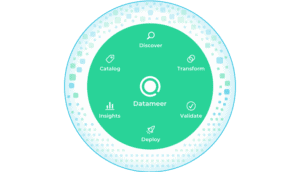5 data-driven marketing trends to look forward to in 2023
- Ndz Anthony
- January 5, 2023

As 2022 draws its curtain to a close, you are counting your wins as a business and looking forward to 2023, ready to face it with renewed zeal.
Would you like to get a sneak peek into the future?
Are you a little unsure about what the future holds for you and your business?
What insights or trends should your marketing be aware of as we head into the new year?
To answer this question, let’s first look at what we mean by data-driven marketing.
Data-driven marketing; what is that?
Research firm Gartner defines data-driven marketing as “the use of data acquired through customer interactions and third parties to gain insight on customer motivations, preferences and behaviors.”
Data-driven marketing uses data and analytics to inform and guide marketing strategies and tactics.
As technology evolves and data becomes increasingly accessible, data-driven marketing provides the key to businesses staying up to date with the latest trends and technologies and remaining competitive.
What data-driven marketing trend should we look forward to in 2023?
Five data-driven marketing trends to pay attention to in 2023
In 2023, we can expect to see the following five trends dominate the data-driven marketing landscape:
1. Personalization:
One of the benefits of data-driven marketing is the ability to deliver highly personalized experiences to customers.
By collecting and analyzing data on customer behavior, preferences, and demographics, businesses can create targeted marketing campaigns that speak directly to the needs and interests of individual customers.
A big part of personalization is inclusiveness and diversity. In 2022, this was a trending topic and will continue to be a significant player in 2023.
According to Thinkwithgoogle, brands that support and embody diversity (and inclusiveness, in essence) can build solid and lasting relationships with customers.
We can expect a continued focus on personalization in 2023 as businesses strive to deliver relevant, personalized customer experiences.
2. Artificial Intelligence and Machine Learning:
Artificial intelligence (AI) and machine learning (ML) transform how businesses analyze and use data.
These technologies allow businesses to process and analyze large amounts of data quickly and accurately, making it easier to gain insights and make data-driven decisions.
Tagged the ‘the AI year’ by some, 2022 saw giant strides in Artificial intelligence. Oracle reports that 86% of brands that fully incorporated AI increased customer experience and productivity, resulting in increased conversions and eliminating the risk of human error in addition to other benefits.
In 2023, we can expect more businesses, even smaller brands to leverage AI and ML to optimize their marketing efforts and drive better results.
3. Omnichannel Marketing:
As customers increasingly interact with businesses across multiple channels (e.g., online, in-store, via mobile apps), businesses need to have a holistic, omnichannel approach to marketing.
Collecting and analyzing data from all customer touchpoints can help businesses create a seamless, cohesive experience for customers and better understand their behavior across channels.
And customers are loving it! The ability to start a transaction on mobile and pick it up on other devices without interrupting the flow that’s what omnichannel marketing is about.
Omnichannel marketing will undoubtedly be a key trend in 2023 as more businesses seek to deliver a seamless, cohesive customer experience.
4. Predictive Analytics:
Predictive analytics involves using data and machine learning algorithms to predict future outcomes or trends.
In marketing, this can be used to identify potential customers, predict which marketing tactics will be most effective, and optimize marketing campaigns in real-time.
How can your marketing team get the best predictive analysis in 2023?
They must effectively track engagement from when customers interact with campaigns, move down the funnel to when they ultimately convert, using these data to develop customer personas and identities.
Expect to see more businesses leveraging predictive analytics in 2023 as they seek to stay ahead of the curve and anticipate customer needs.
5. Customer Data Platforms:
A customer data platform (CDP) is a central repository that stores and organizes customer data from multiple sources.
By using a CDP, businesses can create a single, comprehensive view of their customers, allowing them to deliver more personalized and relevant marketing experiences.
A perfect example of a CDP is Datameer.
What can Datameer do for you?
Ryan Goodman, VP of Analytics at Reliant Funding, has this to say about Datameer:
“Datameer lowered our data engineering time by 500% and helped us produce just-in-time analytics that drove business agility.”
In 2023, we can expect to see more businesses investing in CDPs as they seek to understand better and engage with their customers.
In conclusion, data-driven marketing is an increasingly important aspect of modern business, and in 2023 we can expect to see a continued focus on personalization, AI and ML, omnichannel marketing, predictive analytics, and customer data platforms.
The next question is, what factors are driving these changes? Let’s look at this question next.
Factors influencing the 2023 marketing trends.
- Economic uncertainty amidst the 2022 huge layoffs.
This has affected businesses in more ways than ever before. The huge layoffs of staff mean that businesses now has smaller teams who need to consolidate their tools.
And if marketing wants to merge and work with a smaller close-knit functional team, consolidating technical and non-technical members of the team into a single platform is very important to cut down on cost and still get the work done.
What sets Datameer apart is its robust simplicity. Both technical and non-technical members of marketing can work with its no-code interface, with or without SQL knowledge.
2. Privacy concerns
2022 saw a rise in discussions about data privacy and companies were vilified for capturing more data than necessary to boost personalization.
Big tech companies like Meta were in the hit of the discussions.
Earlier in 2022, Google also announced a series of tracking changes that will affect how they collect data for targeted ads from users across the android OS.
This means that there will be new metrics to track and others that will be rendered obsolete. And it also calls for businesses to make the best use of the data at their disposal.
There is the need to consolidate more data sources into one central location so you can look at one dataset.
3. Rise of AR/VR advertising
2022 saw companies go beyond traditional advertising and even venture into unknown waters with Augmented reality/Virtual Reality advertising.
With companies like meta and a few others pioneering this trend, this is sure to take off at an increased pace in 2023.
A perfect tool to leverage in 2023

These trends highlight the importance of data-driven marketing in the modern business world.
2023 will be great for business; the question is, are you ready for it?
Does your business have the right tech stack to gather and leverage data-driven insights?
With Datameer, businesses can access and analyze customer data to inform and guide their marketing efforts, resulting in more targeted, effective campaigns that drive results.
Fully ready for 2023? Almost!


